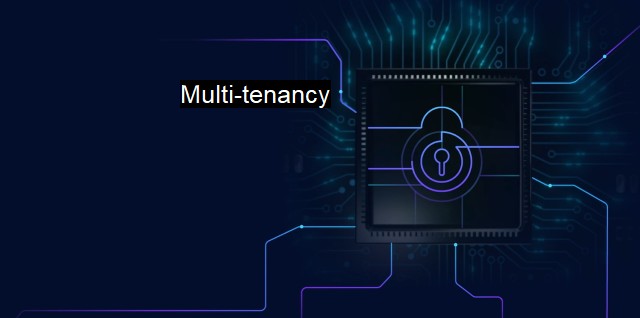What is Multi-tenancy?
Understanding Multi-Tenancy in Cybersecurity and Antivirus: Benefits, Challenges, and Considerations
"Multi-tenancy" is a key term commonly used in the realm of cloud computing, cybersecurity, and antivirus system architecture. The concept is, the boundary separating the individual users, organizations, or entities referred to as "tenants", share common access to a given set of computing resources. The resources usually comprise data storage options, databases, and software applications, maintained and managed by a third-party service provider.In multi-tenancy, tenants operate independently while sharing similar resources. The most convenient way to present the concept of multi-tenancy is to compare it with an apartment building. Each tenant resides independently within their own apartment; they share common spaces like the lobby, parking area, and other facilities. Each tenant’s operations within their unit do not influence the other tenants.
Similarly, in a multi-tenant system, every user has the same access to the software applications. different users have their private individual configurations, data viewer interfaces, and access to the resources that their service provider permits. All these tenants or application users are serviced simultaneously by a single, shared application, yet neither of them is aware of the other's operations. This technique eliminates the need for deploying and managing individual software instances for different users within the same resource pool, reducing hardware requirements and related complexity.
From the cybersecurity perspective, multi-tenancy presents both opportunities and challenges towards maintaining the integrity, confidentiality, and availability of data and services. The shared infrastructure available to multiple tenants propels the demand for efficient access controls, partitioning mechanisms, and robust data protection measures.
Simultaneously, security policies can consolidate efficiently due to the shared, homogenous nature of the environment, making it an excellent ground for the deployment of robust antivirus, firewalls, IDS/IPS, and other defenses. This makes multi-tenancy a significantly cost-effective cybersecurity model, reducing redundancy and optimizing resource deployment.
Multi-tenancy in terms of antivirus systems brings along the supervision of different tenants by a single antivirus solution. Such applications in a multi-tenant environment ensure an additional level of security by enabling centralized virus definition updates, security patches and a uniform security policy. A single antivirus resource manages data integrity for all tenants, thus promising comprehensive protection against threats.
Multi-tenancy is accompanied by its unique paradigm of risks as well, also known as "privilege escalation". It usually occurs when a user or process accesses resources, features, or services outside its agreed-upon or allocated permissions. The issue of cross-contamination between members also stands out as a major concern in the context of multi-tenancy. Any taint within the system can wildly propagate and affect others, unless correctly isolated.
The design of Market-Leading From security software needs to adopt measures to prevent the manipulation of confidential data during a session, move towards predictive detection rather than time-consuming scan routines, and adopt techniques anticipating cloud-propagated threats to survive in the storm of modern multi-tenant design.
Strictly organized rights and permissions, efficient isolation protocols, incident recognition and responding mechanisms, and strategies to protect the multi-tenant environment from external and internal threats, are all serous aspects of implementing cybersecurity in a multi-tenancy realm. while designing a system around the multi-tenancy model can bring various benefits, it also does warrant a thorough reconsideration and re-implementation of security protocols and systems.

Multi-tenancy FAQs
What is multi-tenancy when it comes to cybersecurity and antivirus?
Multi-tenancy is a concept in which multiple users or tenants share the same system, application or infrastructure. In the context of cybersecurity and antivirus, it means that multiple customers or organizations share the same antivirus software or service.What are the advantages of using a multi-tenant antivirus solution?
The main advantage of using a multi-tenant antivirus solution is cost-effectiveness. It allows multiple organizations to share the same antivirus infrastructure, which reduces the overall cost of ownership. Additionally, it also enables continuous and real-time updates to the antivirus software, which strengthens the overall security posture.What are the potential risks associated with multi-tenant antivirus solutions?
One of the potential risks associated with multi-tenant antivirus solutions is the possibility of data leakage. Since multiple organizations are sharing the same infrastructure, there is a risk that one organization's data may be inadvertently exposed to another organization. Additionally, there is also a risk that one organization's security posture may be compromised due to the actions or activities of another organization sharing the same infrastructure.How can organizations mitigate the risks associated with multi-tenant antivirus solutions?
To mitigate the risks associated with multi-tenant antivirus solutions, organizations should conduct a thorough risk assessment before adopting such solutions. Additionally, they should ensure that the antivirus vendor has implemented adequate security measures to prevent data leakage and unauthorized access. Organizations should also implement their own security controls to monitor and manage the risk associated with shared infrastructure.| | A | | | B | | | C | | | D | | | E | | | F | | | G | | | H | | | I | | | J | | | K | | | L | | | M | |
| | N | | | O | | | P | | | Q | | | R | | | S | | | T | | | U | | | V | | | W | | | X | | | Y | | | Z | |
| | 1 | | | 2 | | | 3 | | | 4 | | | 7 | | | 8 | | |||||||